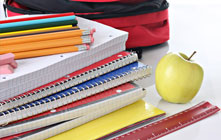8th Grade Games: Fun Educational Games for Eighth Graders
In 8th grade, two of the focus areas in your child's math curriculum are geometry and the number system. Each of these focus areas provide a great opportunity to use fun activities with your child. Take a look at the games below and consider incorporating them into your child's math practice.

What Is My 8th Grader Learning in Math?
Within the number system focus area, your 8th grader will be learning the difference between rational and irrational numbers. Remember, rational numbers are those that can be named and irrational numbers are those that do not have an exact amount that can be identified. In the geometry focus area, one of the skills your child will be learning is how to determine if figures are congruent based on their rotations and reflections.
By 8th grade, your child may be accustomed to learning through lectures rather than hands-on activities. Increase your child's motivation to learn these concepts by providing learning opportunities that are fun and engaging.
Mirror Image
For this activity, you will need a roll of brown craft paper for your child to draw on. Roll out several feet of the craft paper and trace your child's foot and hand. Have your child draw the rotation and reflection of his or her foot and hand. If your child is having difficulty drawing the reflection, feel free to provide him or her with a mirror.
As an extension activity, have your child search for items with a distinguishable shape. Ask him or her to trace the objects onto the craft paper, and then draw the reflection and rotation of these unusual objects.
Draw a Number Sentence
Before beginning this activity, label index cards with 15 positive numbers, 15 negative numbers, five addition signs and five subtraction signs. Divide the cards into three groups and place each group in a bowl. This activity will work best if you mix up the positive and negative number cards, and then divide them into two groups. Have your child draw one card from each bowl.
Your child should use these three cards to create a number sentence to solve. For example, if your child drew cards labeled -5, + and 6, he or she would create a number sentence that looks like this: -5 + 6 = 1. After your child has solved the problem correctly, return the cards to the bowl and create a new problem.
Other Articles You May Be Interested In
-
Do You Believe Computer Games Can Help Your Child in School?

Are video games as big of a negative influence as some parents and adults believe they are, or can they actually help children learn? As a growing number of schools can attest, video games can have a constructive place in the classroom. Should more schools implement them?
-
Remembering the Importance of Memory (Games)

Good memory skills are essential for a successful schooling experience. Read on to find out how memory games can stimulate your child's academic success.
We Found 7 Tutors You Might Be Interested In
Huntington Learning

- What Huntington Learning offers:
- Online and in-center tutoring
- One on one tutoring
- Every Huntington tutor is certified and trained extensively on the most effective teaching methods
K12

- What K12 offers:
- Online tutoring
- Has a strong and effective partnership with public and private schools
- AdvancED-accredited corporation meeting the highest standards of educational management
Kaplan Kids

- What Kaplan Kids offers:
- Online tutoring
- Customized learning plans
- Real-Time Progress Reports track your child's progress
Kumon

- What Kumon offers:
- In-center tutoring
- Individualized programs for your child
- Helps your child develop the skills and study habits needed to improve their academic performance
Sylvan Learning

- What Sylvan Learning offers:
- Online and in-center tutoring
- Sylvan tutors are certified teachers who provide personalized instruction
- Regular assessment and progress reports
Tutor Doctor

- What Tutor Doctor offers:
- In-Home tutoring
- One on one attention by the tutor
- Develops personlized programs by working with your child's existing homework
TutorVista

- What TutorVista offers:
- Online tutoring
- Student works one-on-one with a professional tutor
- Using the virtual whiteboard workspace to share problems, solutions and explanations